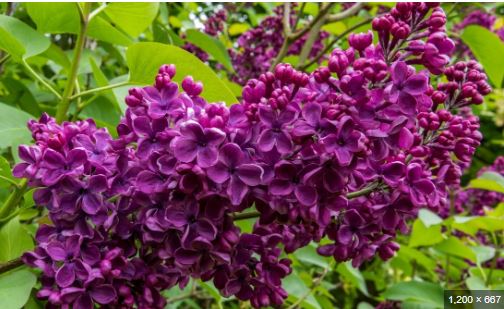
Lilac plants, belonging to the genus Syringa, are popular ornamental shrubs and small trees. They are most famous for their clusters of small, tubular flowers that come in shades of purple, lavender, blue, pink, white, and sometimes yellow. The flowers are often highly fragrant. Lilacs generally bloom in late spring, although the exact timing can depend on the variety and local climate.
Most lilacs grow as multi-stemmed shrubs, but some varieties can be trained into small trees. They vary widely in size from dwarf varieties that might only reach 4-5 feet to standard varieties that can grow up to 15-20 feet or more. Lilac leaves are heart-shaped or ovate, and they provide a lush green backdrop during the growing season. Some species offer fall color.
Lilac Plants
Common Lilac (Syringa vulgaris)
- Features: Classic lilac scent, heart-shaped leaves, flowers in shades of purple, lavender, white, pink, and even magenta.
- Blooms: Late spring.
Persian Lilac (Syringa x persica)
- Features: Smaller and more delicate than the common lilac, with a lighter fragrance. Flowers are usually pale lavender.
- Blooms: Early spring.
Dwarf Korean Lilac (Syringa meyeri ‘Palibin’)
- Features: Compact size, making it ideal for small gardens. Pinkish-lavender flowers, less fragrant.
- Blooms: Late spring.
Japanese Tree Lilac (Syringa reticulata)
- Features: Grows as a small tree or large shrub, white flowers, and has a different structure with cherry-like bark.
- Blooms: Early summer.
Preston Lilac (Syringa x prestoniae)
- Features: Known for its hardiness, flowers later than common lilacs, with blooms in pink or purplish hues, very fragrant.
- Blooms: Late spring to early summer.
Sensation Lilac (Syringa vulgaris ‘Sensation’)
- Features: Unique for its bi-colored flowers, with deep purple florets edged in white.
- Blooms: Spring.
Madame Lemoine (Syringa vulgaris ‘Madame Lemoine’)
- Features: Double white flowers, highly fragrant, one of the most popular white lilac varieties.
- Blooms: Mid-spring.
Charles Joly (Syringa vulgaris ‘Charles Joly’)
- Features: Dark purple, double flowers, very aromatic.
- Blooms: Spring.
Miss Kim Lilac (Syringa pubescens subsp. patula ‘Miss Kim’)
- Features: Known for its late bloom, compact form, and leaves that turn burgundy in the fall. Light purple flowers.
- Blooms: Late spring, sometimes with a second, lighter bloom in summer.
Beauty of Moscow (Syringa vulgaris ‘Krasavitsa Moskvy’)
- Features: Double flowers that start as pink buds and open to white, with a strong, pleasant fragrance.
- Blooms: Mid-spring.
Bloomerang Lilac (Syringa ‘Penda’)
- Features: Notable for reblooming in summer and fall after the initial spring bloom. Purple-pink flowers.
- Blooms: Spring, with repeat blooms.
Josee Reblooming Lilac (Syringa ‘Josee’)
- Features: Lavender-pink, fragrant flowers. Compact and reblooms sporadically through the season.
- Blooms: Spring and then intermittently.
Agincourt Beauty (Syringa vulgaris ‘Agincourt Beauty’)
- Features: Very large, vivid purple flowers, known for its exceptional bloom size and color intensity.
- Blooms: Spring.
Yankee Doodle (Syringa vulgaris ‘Yankee Doodle’)
- Features: Deep, dark purple single flowers, one of the darkest lilacs available.
- Blooms: Spring.
Ludwig Spaeth (Syringa vulgaris ‘Andenken an Ludwig Späth’)
- Features: Rich, dark reddish-purple flowers, less fragrant than some but very striking.
- Blooms: Late spring.
Tinkerbelle Lilac (Syringa ‘Bailbelle’)
- Features: Dwarf variety with wine-red buds that open to pink flowers, spicy fragrance.
- Blooms: Spring.
Wonderblue (Syringa vulgaris ‘Wonderblue’)
- Features: Known for its sky-blue flowers, which is a rarer color in lilacs, very fragrant.
- Blooms: Spring.
Pocahontas (Syringa vulgaris ‘Pocahontas’)
- Features: Early blooming with deep, purple-maroon flowers, compact growth.
- Blooms: Early to mid-spring.
Maiden’s Blush (Syringa vulgaris ‘Maiden’s Blush’)
- Features: Flowers start as a deep pink and fade to a blush, very sweet fragrance.
- Blooms: Spring.
President Grevy (Syringa vulgaris ‘President Grévy’)
- Features: Double blue-lavender flowers, large flower heads, and very fragrant.
- Blooms: Mid-spring.
Syringa yunnanensis (Chinese Lilac)
- Features: Often has a more delicate appearance, with pinkish or light purple flowers, less dense foliage.
- Blooms: Late spring.
Cultivation
- Sunlight: Lilacs thrive in full sun, requiring at least 6 hours of direct sunlight daily for the best bloom.
- Soil: They prefer well-drained, neutral to slightly alkaline soil. Lilacs can tolerate clay soil if it’s not too compacted or waterlogged.
- Watering: Once established, lilacs are relatively drought-tolerant, but they benefit from regular watering during dry spells, especially in their first few years.
- Pruning:
- Prune lilacs soon after they finish blooming because they set next year’s flower buds shortly after flowering.
- Remove spent flower heads to prevent seed formation, which can redirect energy from flower production.
- Old, overgrown lilacs can be rejuvenated by cutting back one-third of the oldest branches to the ground each year for three years.
- Fertilization: A light application of a balanced fertilizer in early spring can encourage growth and flowering, but over-fertilization can reduce flowering.
- Propagation: Lilacs can be propagated through cuttings, layering, or grafting. Suckers (shoots growing from the base of the plant) can also be removed and replanted.
Common Issues
- Pests: Lilacs can be affected by pests like borers, scale, and leaf miners. Regular inspection helps in early detection and management.
- Diseases: Powdery mildew is common, especially in humid conditions or where air circulation is poor. Choosing resistant varieties, ensuring good air flow, and avoiding overhead watering can mitigate this.
- Non-blooming: If a lilac fails to bloom, it might be due to insufficient sunlight, improper pruning, or the plant might be too young. Most lilacs take a few years to start blooming after planting.